The Woolwich Attack: Analysing Dynamics of Polarisation and Reconciliation on Twitter and on the Ground
Team members
Phillip Anderson, Joram Binsbergen, Chelsea Jang, Sotiris Sideris, Alexandros Valarakis, Nicholas Vieira, Fernando van der Vlist
- The Woolwich Attack: Analysing Dynamics of Polarisation and Reconciliation on Twitter and on the Ground
Summary of key findings
- Extremist Islamic actions, such as a terrorist atrocity or murder, strengthens far right extremist ideologies and sentiment. Moreover, this tendency is enhanced, over time, by a growing polarisation between EDL supporters against the wider anti-EDL and anti-Racist community. This strengthening is also increased by Muslims who are against anti-Muslim hate speech. Furthermore, it can be concluded that digital methods can portray offline realities, and can conclusively be used in order to study this phenomenon in more depth than traditional methods.
- There was no discovery of extreme Islamist discourse since they are using more private means of communication than an open platform like Twitter.
- Main clustering and discussion is evolved between the extreme far right versus the anti-fascist and anti-extremist. This fact leads us to the conclusion that they have a symbiotic relationship.
- EDL is centralized with top-down groups of users while anti-EDL is more decentralised. Both parties are extremely active though.
- Reconciliation efforts generally perpetrated by individual users and some key members of the community.
1. Introduction
In 2013, eight years since al-Qaeda inspired terrorists had last killed people on British soil during the 7/7 attacks1, homegrown Islamic extremists Michael Adebowale and Michael Adebolajo brutally murdered an off-duty British soldier, Drummer Lee Rigby of the Royal Regiment of Fusiliers, in the middle of a street in Woolwich, South-East London. On the afternoon of 22nd May and armed with a meat cleaver and knives, the attackers ran the soldier over with a car before Adebolajo attempted to decapitate him2, whilst Adebowale hacked at his body until he died at the scene. With the blood of the victim on his hands, Adebolajo tried to justify the murder through the lens of a camera after urging a passerby to record a video of him², where he states that we must fight them like they fight us, an eye for an eye and a tooth for a tooth. Neither of the murderers attempted to flee or hide, nor did they attack onlookers, instead waiting for armed police to arrive which they later charged at, and were subsequently shot and immobilized. Before receiving their prison life sentences in December, they claimed in court that they had wanted to be shot and killed, believing that it would make them martyrs (Manning).
Adebolajos statements in the amateur footage taken moments after the murder are similar to declarations made by the extremist jihadist 7/7 attackers, where one of the London bombers claimed in a pre-recorded video that we are at war, I am a soldier, and now you too will taste the reality of this situation (Woolwich: The Untold Story). In the Woolwich footage3, Adebolajo talks about my people and my brothers, and at one stage our soldiers, whilst justifying the murder in the name of global jihad. With a strong connection to the UK, and seemingly no connection to Iraq or Afghanistan, Adebolajo came to view the bloodshed in Iraq and Afghanistan as the blood of his own brothers and sisters, due to the culmination of a 10-year period of Islamic radicalisation. From a devout Christian family, British-born Adebolajo converted to Islam in 2003 and formed strong links with the banned extreme Islamic sect al-Muhajiroun, and their former leader Anjem Choudary, who stated that Adebolajo "was on our ideological wave-length" (Laville, Walker and Dodd). Once described as the most extreme Islamist group operating in the West, Al-Muhajiroun was based in Britain and had branches in many other countries (Pipes). Its main aim included the worldwide creation of an Islamic state under sharia law, by the union of dawah (the call to Islam) and jihad (struggle), and it pursued this aim by spreading propaganda on the streets of Britain, whilst also aiding domestic and international terrorism (Hope Not Hate, The Al-Muhajiroun network). This is highlighted in their infamous track record, where 18% of the 134 Muslims convicted on terrorism charges in the UK have been associated with the organisation, including the masterminds behind 3 of the UKs largest terrorist plots (Simcox. et al). Islamic extremist groups such as al-Muhajiroun preach to their followers through mosques, study groups and on demonstrations but increasingly they spread their messages via Internet (Lowles and Mulhall 17). However, their use of social media is basic and online dissemination of their ideology is primarily achieved through a plethora of dedicated jihadist sites, video and audio lectures, online publications and specific closed internet forums (Lowles and Mulhall 18). The emergence of so called counter-Jihad groups such as the English Defense League (EDL) challenge the ideological rhetoric of extremist groups such as al-Muhajiroun. Indeed, it has been the actions of this organisation that gave rise to the EDL in the first place, and they benefited hugely from the burning of poppies by Muslim Against Crusades, who are strongly associated with Choudary, during Remembrance Day in 2010, and the murder of Lee Rigby in 2013 (Lowles and Mulhall 58). Both of these violent and offensive acts generated the biggest spikes in support for the EDL, helping the organisation off of life support and allowing it to bolster its membership (Lowles and Mulhall 58)
Paul Jackson depicts the EDL as a social movement gravitating around a new far right ideology, which consists of a loose set of views that presents a clear politicised approach to social issues by combining ultra-patriotism, a critique of mainstream politics, and an aggressive anti-Muslim agenda (Jackson 5). Although the group has a limited central organisational structure, it does offer a level of coherent organisation and a broad party manifesto to a wider set of networked followers (Jackson 5). However, it is also heavily reliant upon grassroots networks, such as the Casuals United organization4, and the initiative of regional leaders to develop its division-based activism (Jackson 5). This activity consists of series high profile street demonstrations that seek to whip up tensions and violence between Muslim and non-Muslim communities (Hope Not Hate, What is the English Defense League?; Jackson 5). For instance, soon after the Woolwich murder the EDL organised a protest march in London on the 27th May, where over 1,000 supporters chanted "there's only one Lee Rigby" and listened to former leader Tommy Robinson blame Islam for the Woolwich murders (Quinn). There is a clear symbiotic relationship between al-Muhajiroun and the EDL, as they feed off the other and justify their own existence by the existence of the other (Lowles and Mulhall 5). Recent years have seen an increased interest in the online presence of extreme far right groups. Although originally comprising of dedicated websites for the dissemination of hate content, the online British far right currently incorporates multiple networks, including social media platforms such as Facebook and Twitter, which are used for community formation around variants of extreme right ideology (OCallaghan et al.). Similarly, the EDL can be described as a social media led organisation that has sizeable and active presence throughout the aforementioned platforms. Furthermore, the first study of anti-Muslim sentiment in the UK found that EDL members were linked to a third of online abuse incidents in the past year (Copsey et al.). Hope Not Hate notes the group has certainly gained a large increase in social media followers since Lee Rigbys murder, however building an accurate picture of its membership has proved difficult (What is the English Defense League?).
The news of the murder was quickly spread across the Internet through Twitter by an eyewitness who live tweeted the events of the murder at the scene. In addition, Adebolajos video brought large repercussions online, drawing 1.2 million visitors to ITVs website where the video was posted (Halliday). Therefore, it was a natural step to infer that this event of a shocking and political nature, and a fundamental part of which is a redistributable digital object, will have an impact on the discourse among the social media users.
2. Polarisation and reconciliation on Twitter and on the ground
Richard Rogers has suggested a periodization based on how Twitter has been conceived as an object of study (Debanalizing Twitter). Starting from its initial development in 2006 until roughly 2009, Twitter was generally characterised as an ambient friend-following and messaging utility, or an urban lifestyle tool with many tweets on mundane activities such as lying in bed or taking a walk in the park (356). Research on the platform in this first stage or tradition (Twitter I) is often directed at determining the value of tweets and the degree to which messages are banal, thus focussing mostly on the content (357). Characterised by a tagline change from What are you doing? to Whats happening? in 2009, a second phase or tradition (Twitter II) conceives of Twitter as an event-following tool, a way to monitor, for instance, elections or disasters (Rogers, Digital Methods 359; Bruns and Liang). In 2010, Twitter introduced a Trending Topics section to users as an attempt to identify the hottest emerging topics of discussion, prompting co-founder Biz Stone to characterize the platform as a discovery engine for finding out what is happening right now. Trending Topics lends itself to the user furnished #hashtag, which acts as a device-specific method to organise tweets around specific users, groups, themes, or events. Similarly, tweets can also be directed at specific individuals, and it is through the @reply feature that public Twitter-based conversation occurs (boyd, Golder and Lotan). Scholars have also observed Twitters capacity to act as a tool for following, reporting, and breaking, news events (Arceneaux and Schmitz Weiss). During event related research, the #hashtag becomes the means to follow and mobilise actors, as well as to categorise sets of tweets in order to study an event online and follow the actions on the ground (Rogers, Digital Methods 360). This stage of Twitter research is thus gradually shifting towards a third phase or tradition (Twitter III) that is interested in Twitter as it is settling into a massive data set, which is of value to itself but is also of historical value as part of cultural heritage (Rogers, Digital Methods 362).
Continuing in particular the second and third stages, in this study we relate dynamics of polarisation and reconciliation at four different points in time that are significant for what has come to be known as the Woolwich murder in online networked publics on Twitter to how those same dynamics play out as events on the ground (boyd). In other words, our objective is to study the spillovers or interactions between online and offline dimensions of a controversy with extremist actors. In a recent report, Chan, Ghose and Seamans have performed a similar type of study for racial hate crimes on the Internet between 1999 and 2008. Based on regression analysis, their study concluded that there is indeed a strong correlation between availability of Internet in particular areas and the numbers of racial hate crimes for those areas. Moreover, areas with greater levels of population density and racial segregation showed stronger results. This study, however, grounds its claims in the online, which means that we are not so much researching the Internet and its users, as studying culture and society with the Internet (Rogers, Digital Methods 38). In regards to dynamics of polarisation and reconciliation online, scholars have studied patterns of political polarisation among Twitter users and discovered that retweet-networks among users showed a clear polarization (Conover et al.). Users with extreme left or right-wing tendencies tend to retweet more from within their own communities rather than from the opposing ones. They retweet to redistribute and reinforce their own political views. Hashtags, however, were used to interact with the opposing communities so as to infiltrate or inject biased content into the information stream (Conover et al. 7). This pattern of aggravating or amplifying polarisation through provocation with extremist political comments has been identified as constituting an echo chamber (Sunstein; see also Rieder).
The ephemerality of Twitter then points to the need to study the relationship between the events on the ground and the change of network patterns in online communication. Some scholars have presumed a correlation between them, specifically when the event was large in scale and involved multiple political stances (Thelwall; Mitchell and Hitlin). Mike Thelwall investigated the reason why certain events are subject to reverberation among the Twitter users, based on the assumption that strong emotions invoked by particular events are the driving force of the continuing resonance. Mitchell and Hitlin found that whether the nature of the events is positive or negative does not affect the general tendency of the emotions displayed on Twitter. During popular events, general sentiment on Twitter showed little change and the role of negative sentiment was far higher than the positive sentiment in the sharp increase of the number of Tweets during the events (Mitchell and Hitlin 10). Returning to the Woolwich murder, the news of the murder of Lee Rigby rapidly spread from the eye-witness Tweet via locals to the larger public. Five days later, extremist political actors such as the EDL had already physically mobilised in a protest march. Starbird, Muzny and Palen developed a machine learning process to classify twitter users, focusing on determining who is on site during a mass disruption event and who are the remote crowds (4). They considered the remote crowd mainly as a noise to filter out, because those on the ground can be a valuable source of information (3). This report does not contest the idea that Tweets composed by those who are physically present are valuable. Rather, its focus will embrace the remote crowd as a significant factor that exacerbates the polarisation in networked publics.
3. Research question
In what way are dynamics of polarisation and reconciliation of the Woolwich controversy on Twitter reflected, influenced by, or otherwise correlated with events happening over time on the ground?
4. Methodology
There are limitations to understanding Twitter as a data provision machine, most importantly those related to Twitters ephemerality (Rogers, Debanalizing Twitter 362). Back et al. and Elmer have both enquired into how real-time research poses new challenges as a result of the problem of ephemerality. For Elmer, streams of data especially on Twitter pose new challenges to research on political communications campaigns, and the analysis of vertical tickers highlights the fleeting character of networked and socially mediated communications (25). Furthermore, Marres and Weltevrede offer an operational analytical framework as they investigate the device of scraping. In particular, they show how scraping imports analytical presumptions into the research, and also that scrapers import data that is already pre-formatted. As a consequence of this, they raise the question of whether the research helps to bring into view the dynamics of media platforms or also those of the social phenomena they enable? To operationalise that question, they suggest a distinguish between two kinds of real-time research: those dedicated to monitoring live content (which terms are current?) and those concerned with analysing the liveliness of issues (which topics are happening?) (Rogers, Debanalizing Twitter 356). Where live social research renders analytically productive the formatted, dynamic character of digital networked data (Marres and Weltevrede 15), which means that it makes possible the study of changing natively digital objects, research on liveliness on the other hand aims to capture what is currently happening in a particular social space; which actors are the most active and make things happen in the eternal now.
A digital methods approach offers one solution to the problems posed by live social research: by following the medium and its natively digital objects it is better prepared to handle such changing objects (Rogers, Digital Methods). Specifically, we will be studying Twitter with medium-specific approaches that follow the medium by repurposing the devices and techniques of the platform, in order to see whether we may develop claims about culture and societal change more broadly. According to Rogers, Twitter is particularly attractive for research owing to the relative ease with which tweets are gathered and collections are made, as well as the in-built means of analysis, including RT (retweets) for significant tweets, #hashtags for subject matter categorization, @replies as well as following/followers for network analysis and shortened URLs for reference analysis. Given its character limit and the fact that each tweet in a collection is relatively the same length, it also lends itself well to textual analysis, including co-word analysis (Rogers, Digital Methods 362). Each of these elements are native or device-specific, and can to a specified degree be accessed through application programming interfaces (APIs), this is part of what Puschmann and Burgess call the politics of Twitter data: the negotiations of the platform provider with the end users through terms of service and application programming interfaces. Following the nativeness of the data means that it is pre-formatted (which is precisely what makes it specific) in so-called JavaScript Object Notation (JSON), an open data-interchange standard. Consequently, Borra and Rieder are right to stay as close to follow the native format of the data as much as possible to introduce as little bias as possible in developing the DMI-TCAT tool we will be using here (Programmed Method). It also means, perhaps amplified in part by the collapse of context that Marwick and boyd observe, that the methods used to acquire tweets will inherently include a portion of tweets that is not necessarily relevant, but simply matches the query.5
5. Methods
Drawing from a general dataset of Twitter messages concerning the murder of Lee Rigby, and the presence and interaction of the EDL in particular, we aim to analyse how dynamics of polarization and reconciliation in online Twitter networks are reflected by events happening over time on the ground and vice versa.
5.1. DMI-TCAT dataset
The dataset comprises a historical set of tweets acquired from data reseller Gnip6 that was imported into Digital Methods Initiative Twitter Capturing and Analysis Toolset (DMI-TCAT)7. The dataset woolwich_historical comprises roughly 1.8 million tweets extracted from the period between the 21st May and 22nd June 2013. Within this dataset, tweets are captured if at least one of the following keywords is used: woolwich, leerigby, ripleerigby, leerigbyrip, rigby, edl, bnp, duggan, markduggan, or adebolajo. However, it should be noted that as we have worked with a historical dataset from Gnip we did not specify the above query design ourselves. As Rogers points out the #hashtag included in a tweet becomes the means to follow a certain topic online (Debanalizing Twitter 360). By using a digital methods approach one can categorize a set of tweets based on the keywords and technical metrics used in the message. Nevertheless, it is also important to note that any Twitter user can select arbitrary hashtags to annotate his or her tweets. This also allows users to produce tweets with multiple unrelated or even contradicting hashtags in order to reach a wider audience, or to magnify their viewpoint to a specific user group. The latter is a common practice that Conover et al. describe as content injection (94). As a consequence we have to take into account that the dataset contains arbitrary messages. For example, the keyword woolwich returns many messages about the region that are not related to the actual murder, and to a bigger extent, tweets with the keyword rigby show up because Rigby itself is a common British surname.

Fig. 1: Overview of the full woolwich_historical dataset, as captured from May 21st, 2013 to June 22, 2013. Source: DMI Twitter Capturing and Analysis Toolset (DMI-TCAT) (https://tools.digitalmethods.net/coword/twitter/analysis/).
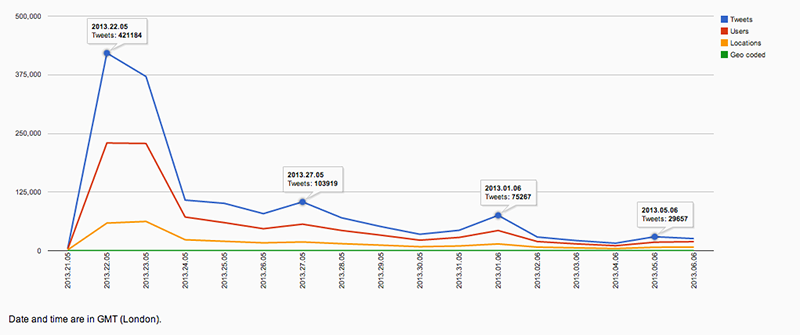
Fig. 2: Twitter interaction frequency spikes in the woolwich_historical dataset between May 1st, 2013 and June 6th, 2013. Source: DMI Twitter Capturing and Analysis Toolset (DMI-TCAT) (https://tools.digitalmethods.net/coword/twitter/analysis/).
More specifically, this research examines how groups of Twitter users are formed around the reactions of the Lee Rigby murder and subsequent related events. By analyzing the key actors for each cluster, we aim to compare polarization and reconciliation as indicated by the connectivity in mention graphs, with events on the ground. There are four distinct spikes in Twitter activity throughout the woolwich_historical dataset (Figure 2). The major spike occurs on the 22nd May, soon after the murder of Lee Rigby takes place. The second spike is on 27th May, as on this day the EDL held a march with over 1,000 supporters to protest against Islam and the death of Rigby. The third spike takes place on 1st June, on this day Adebolajo is charged with the murder of Rigby, and the last spike is on 5th June, when Adebolajos pre-trial hearing is held. To get a better understanding of the content in Twitter messages, this study first looks at the general statistics for each day. We analyzed the top RT to see which messages were the most popular, we identified the key actors to see who is participating in this debate, and we mapped out the most popular hashtags for each day to see whether the emphasis changed over time.
5.2. Mention network analysis
We used the social graph by mentions dataset to illuminate communities and key actors surrounding the online communication about the Woolwich murder. In order to portray how the communities and key actors changed over time, we compared the mention graph for each selected day. The mention graphs show which users are the most mentioned, and which users tweet, or mention other users, the most often. The more often a user mentions another, the stronger the link.
5.3. Co-hashtag analysis
Analyzing how hashtags are used in conjunction with one and other allows for a better understanding of the key themes in the conversation taking place within our dataset. Using the DMI-TCAT tool, we analyzed co-hashtag graphs for the aforementioned spikes in the activity graph. By downloading the hashtag co-occurrence data, we were able to generate the graphs in Gephi, in these undirected graphs each hashtag forms a connection with another hashtag if they are used in a tweet together. The more often they appear together, the stronger the link. By comparing the co-hashtag graphs along with the hashtag frequency charts we will be able to see which was the dominant figure within the discussion and with whom it was interacting. Comparing these findings with the mention analysis we will be in a position to analyze the polarization of the platform with more evidence supporting our claims.
5.4. Gephi
The Gephi visualisation software was used to generate both the mention and co-hashtag graphs. ForceAtlas2, a built in algorithm, allowed the graphs to be consistently representative of the dataset. Co-mention graphs were clustered and colored based on modularity class, and the nodes ranked by degree (size of the node). Settings such as scaling, gravity, and prevent overlap were utilized in order to make the visualizations more readable and explicative. In the preview workspace, settings such as node outline color, curved edges, fonts, and transparency were manipulated to make the graphs more aesthetically pleasing.
5.5. SentiStrength
In addition, we tried to backup or complement our findings about polarization and reconciliation with sentiment analysis of the most popular EDL tweets. Since we could not locate distinct extremism clusters by scraping extremist keywords and hashtags, we could not directly compare extremist right sentiment with jihadist sentiment around the murder of Rigby. Therefore we choose to create a subset of the most popular EDL messages. We used the DMI-TCAT tool and filtered the days with the aforementioned spikes to analyse for tweets which contained the keyword EDL. We then extracted all the messages from this subset that were RT at least two times to get the most popular content. With SentiStrength8 we were able to extract sentiment values for each individual tweet, based on a predefined dictionary SentiStrength applies both a positive and a negative value to each message. Words in the dictionary range from 1 and 5 for positive, and -1 and -5 for negative sentiment, where 1 and -1 signifies neutral sentiment. We then collected the sentiment values for every message and counted the total amount of messages for each of the five sentiment values. The totals for each day are made into a visualization which shows the degree of positive and negative sentiment relative to the total dataset.
6. Findings
6.1. Mention analysis
6.1.1. 22nd May 2013
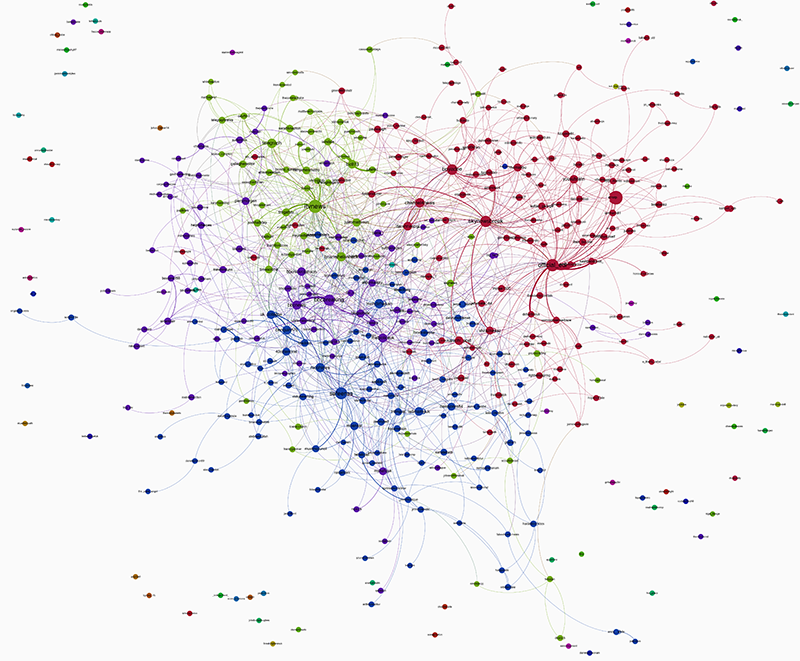
Fig. 3: Social graph by mentions for 22nd May 2013 for the woolwich_historical dataset. Data from DMI Twitter Capturing and Analysis Toolset (DMI-TCAT) (https://tools.digitalmethods.net/coword/twitter/analysis/), visualised with Gephi. (PDF)
Figure 3 portrays the mention network during the day of the murder, where we can observe the presence of 4 clusters each with 2-3 dominant nodes that are generally media-related accounts. The attack took place between 14:21-14:23, and the police arrived at the murder scene at 14:34 and non-fatally shot the suspects soon after. In addition, the amateur footage of the suspects moments after the murder began to circulate at around 18:00, and the UK Prime Minister David Cameron condemned the attack soon after, describing the incident as truly shocking (Grierson). As details of the attack emerged, Twitter became a medium to follow the events on the ground and acted as a news medium. For example, the most interconnected account on this day was @BBCBreaking (BBC News) with 11,537 mentions, situated in the centre of the graph and surrounded by other official BBC related nodes such as @bbcnews, @bbcnickrobinson, and @BBCNormanS, alongside the official London police account (@metpoliceuk). Indeed, the most RT tweet (3,493 times) belonged to the BBC:
@BBCBreaking: Muslim Council of Britain condemns attack in #Woolwich as a barbaric act that has no basis in Islam http://t.co/ea6TgA0S
The cluster shaded in red and towards the upper-right of the graph is dominated by two similar degree sized nodes, those being @Official_EDL, the far right groups official Twitter account, which was the second most frequently mentioned account 11,024 times, followed by @SkyNewsBreak (Sky News) with 9,446 mentions. In addition, this cluster also accommodates the prominent media related accounts of @Channel4News and @darshnasonic, a reporter for Channel 4 News, and the visibly interconnected @BOYADEE. We believe the latter to be a strong interconnected node as this user broke the news on Twitter with a series of live-tweets that documented the entirety of the murder. Hence this user generated one of the biggest reactions and was mentioned in 4,927 tweets, ranking the fifth most mentioned that day. The following tweet highlights this claim:
@thedailybeast: Witnessing a beheading in progress aspiring rapper @boyadee live-tweets the London terror attack http://t.co/9LYKcKbO
The existence of 4 clusters, one of them highly interconnected, which are dominated by news related nodes and the user who broke the news confirms the notion that Twitter can be considered as an object for news dissemination and following, especially during events of shocking nature. We can also discover that a small number of opinion leaders lead discussion and played a key role in spreading the news (Wu et al. 14). However, influential Twitter accounts and tweets can shape the narrative of how facts are read, and no group understood this more clearly than the EDL, who were a powerful force in the discussion and perniciously used their account to steer their narrative of an attack by Islam against all of us. The following tweet was RT 480 times:
@Official_EDL: CONFIRMED WE HAVE BEEN SUBJECT TO A TERROR ATTACK BY ISLAM WE ARE CURRENTLY UNDER ATTACK
Over the course of events, the @Official_EDL account was also used to organise activists on the ground. As previously mentioned, the EDL are an active force on Twitter and in the past have used the platform to rally for support. During the day of the murder their account was intensely active and received many more RT and mentions than some news organisations who were documenting the murder. The following tweet was RT 992 times:
@Official_EDL: EDL leader Tommy Robinson on way to Woolwich now Take to the streets peeps ENOUGH IS ENOUGH
However within this cluster there were also users who attempted to defuse the escalating anti-Muslim and racist sentiment. Although a relatively small node in Figure 3, the following tweet by @hdck69 who was the eighth most mentioned user, was RT 3,087 times:
@hdck69: I've served my country all over the world. And you know what? Muslims are the friendliest most tolerant & hospitable people. #woolwich
Moreover, the blue cluster towards the bottom of the graph comprises prolific and well-known left-leaning news journalists such as @mehdirhasan, The Huffington Post UK's political director, and @OwenJones84, a columnist for The Independent, who were also quick to condemn both the attack and the EDL's online behaviour, with @OwenJones84 describing them as "thugs". , Other notable interconnected nodes include @benquinn75, a reporter for The Guardian, @TellMamaUK, a public service for measuring and monitoring anti-Muslim attacks, the @MuslimCouncil, who are the UK's largest Muslim umbrella body, and @MoAnsar, a prominent British Muslim political and social commentator who is known for his opposition to the far right and Muslim extremism. However, the most interconnected node within this cluster is @SafeensS, who was responsible for 81 tweets that made up the second highest amount that day. Similar to @hdck69, we believe @SafeensS is a significant node due to various anti-extremist tweets, aimed at countering the EDL's blame and retaliation against the wider Muslim community by including the hashtag #EDL in a series of tweet, below serves as an example:
@SafeensS: White black Muslim Christian don't matter. killer is a killer according to The Quran.Don't confused #woolwich #EDL http://t
Located directly above this interconnected cluster, we can identify a secondary green cluster around the dominant and highly valiant node @itvnews, one of the biggest news organizations in Britain. This node is surrounded by a majority of other news related nodes such as that of @TimGattITV, an Editor for ITV, the @Telegraph newspaper, @brianwhelanhack, a Channel 4 and Sunday Times reporter, and the London talk radio station LBC 97.3 (@lbc973).
Most mentions: @bbcbreaking (11,537), @Official_edl (11,024), @SkyNewsBreak (9,446), @piersmorgan (5,278), @Boyadee (4,927).
Most tweets: @Errotp (195), @SafeensS (81), @joncarlosguerra (78), @bnp_manten (52), @DefiantLionUK (50).
6.1.2. 27th May 2013

Fig. 4: Social graph by mentions for 27th May 2013 for the woolwich_historical dataset. Data from DMI Twitter Capturing and Analysis Toolset (DMI-TCAT) (https://tools.digitalmethods.net/coword/twitter/analysis/), visualised with Gephi. (PDF)
On this date an EDL march took place in London with over 1,000 supporters, and two people were arrested following a retaliatory arson attack at a mosque in the north-eastern town of Grimsby. In addition, news spread that Help For Heroes, a UK military charity that provides support for injured army personnel and their families, was rejecting donations from Tommy Robinson and the EDL based on the charitys non-political stance. Although the two arrests in relation to the mosque attack had no direct connection to the EDL, the above actions generally strengthened community polarization and added to the growing far right resentment. However, an attempted act of reconciliation took place in York where a mosque countered a local EDL protest and invited its members for tea and biscuits, which defused tensions on the ground. This lead to a string of reconciliation tweets, below is an example by @oceanclub that was RT 1,208 times and the 4th highest for this day:
@oceanclub: EDL march on mosque. Mosque sends out tea (with sugar bowl). Everybody plays soccer. THIS IS ENGLAND: https://t.co/JKRKSX8hCB
Figure 4 demonstrates the formation of clusters in the wider discussion surrounding the murder of Lee Rigby, and more specifically, around the events that took place though the day. The main finding in this graph is how conversation is structured, and polarized. The cluster on the lower left is comprised of mostly extreme far right users and EDL followers, and the center and further right is representative of general anti-far right and anti-racist users, amongst them various journalists and authors. The far right cluster includes the second and fourth most frequently mentioned users, and highlights their dominance in the conversation. The second most mentioned user was the EDLs ex-leader Tommy Robinson (@EDLTrobinson) with 3,241 mentions, and the fourth was @Official_EDL with 2,588 mentions, both nodes dominate the lower left cluster, and are interconnected with other notable far right supporters such as @XxPLWxX, @IslamOUTofUK, @EnglishMaker, and @DefiantLionUK. All of the latter either qualify as far right followers based on their tweets, and profile page descriptions which clearly stated they are anti-Islam and support the EDL Note that this tightly formed cluster comprises of interconnected nodes that form conversation around two central nodes, with lesser connections to the main conversation cluster, thus signifying the polarization of a community. Due to the EDL protest taking place, we can observe that both accounts served as an information platform as events unfolded throughout the day:
@Official_EDL: Thousands gather to support our troops ! http://t.co/EqC3P6nKW5
@EDLTrobinson: Anti troop protesters have occupied demo space there will be a slight delay whilst police move them. Thousands of Edl
The central cluster in Figure 4 includes the dominant node @HelpforHeroes, who were the most mentioned account in tweets, with 4,219 mentions, due to the charitys restriction on accepting EDL related donations. The 6th highest RT tweet of this day (922 times) highlights its importance in the conversation:
@BBCBreaking: Armed forces charity @HelpforHeroes refuses donations from far-right English Defence League after
However this did not go without contestation from supporters of the EDL, as the below tweet by @codylachey exemplifies:
@codylachey58: got to say as an ex soldier im disappointed that @HelpforHeroes have said they won't accept donation's from @EDLTrobinson
Moreover, @HelpforHeroes is surrounded by 3 visible anti-EDL and anti-racist users that account for the highest amount of tweets that day, in order of @pooblocks, @NorseFired, @RacistBasher, and @malcolmite, who make up this cluster with a majority of other anti-extremist users. The biggest nodes towards the right of the graph, are composed of journalists and authors, including @trillingual (Daniel Trilling) the author of Bloody Nasty People: the Rise of Britain's Far Right, and @OwenJones84. Other notable nodes that make up this spectrum of conversation are @EDLNewsXtra, which reports on EDL activities that they dont want you to hear, and the official account of Unite Against Fascism (@uaf), who generally inject anti-EDL content into the debate. In addition, we can notice that @anjemchoundary (Anjem Choudary), the radical Islam cleric who was closely associated with Lee Rigbys murderers, has an insignificant presence in the conversation due to an extremely low amount of connections with other nodes.
Most mentions: @helpforheroes (4,219), @EDLTrobinson (3,241), @flashboy (3,177), @official_edl (2,588), @owenjones84 (1,844).
Most tweets: @pooblocks (329), @norsefired (223), @racistbasher (211), @malcolmite (196), @ublocks (169).
6.1.3. 1st June 2013
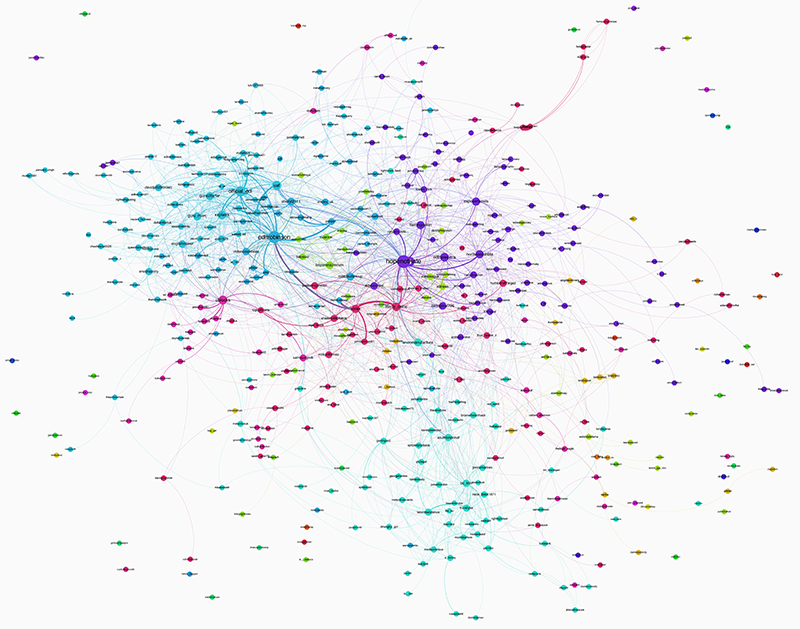
Fig. 5: Social graph by mentions for 1st June 2013 for the woolwich_historical dataset [explain parameters]. Data from DMI Twitter Capturing and Analysis Toolset (DMI-TCAT) (https://tools.digitalmethods.net/coword/twitter/analysis/), visualised with Gephi. (PDF)
After spending 9 days in hospital due to having been shot by police at the murder scene, news of Michael Adebolajo being charged for the murder of Lee Rigby, the attempted murder of two police officers and possession of a firearm, dominated British headlines on the 1st June (BBC News). Moreover, there were also BNP and EDL demonstrations across the country which were met by anti-fascist counter-protests by members of, amongst others, the UAF and Hope Not Hate, which resulted in a series of arrests (ref).
After viewing the Top RT table for the 1st June, it is possible to conclude that negative sentiment aimed at the EDL demonstrations dominated online Twitter discussion. Hence, when looking at Figure 5 we can observe a further polarization between two communities. The main central cluster is dominated by Hope Not Hate (@hopenothate), the most talked about user with 3,204 mentions, who are an anti-extremist British campaign that seek to mobilise support against the BNP and EDL (Hope Not Hate, About Us). The below tweet taken from this day highlights this:
@hopenothate: Today the #EDL march for HATE. they do not speak for Britain they do not speak for me. http://t.co/MWZfTJBps5
The secondary cluster on the left is generally associated with the EDL, with @EDLtrobinson once again a key actor who is strongly interconnected and mentioned 2,507 times. We can also observe the strong presence of @Official_EDL, the 3rd most mentioned user on this day, who is closely interconnected with related far right users such as @EnglishMaker, @Gone2farFar (an anti-Islam page), @XxPLWxX, amongst others. In addition, the presence of @uaf in the left cluster would signify a high interaction between the UAF and the EDL, this is strengthened by reports clashes between the 2 groups in London, which eventually led to the arrest of 58 people (Quinn). The below tweet highlights realities on the ground by both sides:
@uaf: Victory to anti-fascists #BNP did not pass! We are the majority fascists are few. Up + down country we out-numbered them #UAF #NoP
@XxPLWxX: UAF claiming they outnumbered EDL in many places today........ Yeah in police cells.
Surrounding @hopenothate in the centralized cluster, we encounter other anti-far right and anti-extremist nodes such as @EDLNewsXtra, @EDLExposed, @NorthEastAntifa, @exposetweets, and @RacistBasher. Furthermore, @Marty_Caine is situated between both clusters and acts as a bridge between their individual key nodes. On 31st May, Marty Caine, who is a United Kingdom Independence Party (UKIP) activist, branded Lee Rigbys family idiots for issuing an appeal for calm in the wake of their sons murder, and Lowles notes he is infamous for advocating EDL violence (Moon). Hence, we believe his presence as a central node in the graph can be read as one of provocation that has further polarized the community. This is exemplified in the following tweets, which demonstrate the negative sentiment Caines comments caused, and highlight polarization against the EDL:
@kle_b: ""@hopenothate: For rejecting hate #UKIP MEP @Marty_Caine calls the Rigby family idiots/ http://t.co/BXySxMxvwA "" what a monster!
@Redpeter99: The #UKIP joke is no longer funny. Top #UKIP member @Marty_Caine calls Lee Rigby's family ""idiots."" and defends #EDL. Be
Furthermore, the notable presence of @599bt, who produced the highest amount of tweets that day at 195, is also visible in the graph. The following is an example of one of the users top tweets, which highlights the fact that far right groups such as the EDL were exploiting and capitalizing on Lee Rigbys name to further heighten tensions between two communities and achieve their anti-Muslim goals.
@599bt: @EDLTrobinson Dear God. #LeeRigby's family have specifically asked you & the #EDL to stop using his name. You are a disrespectfu
Most mentions: @hopenothate (3,204), @EDLTrobinson (2,507), @official_edl (1,943), @billbragg (1,196) @uaf (1,058).
Most tweets: @599bt (185), @unblocks (172), @poppypride1 (165), @bnparenazsicum (148), @sheryl2311 (125).
6.1.4. 5th June 2013
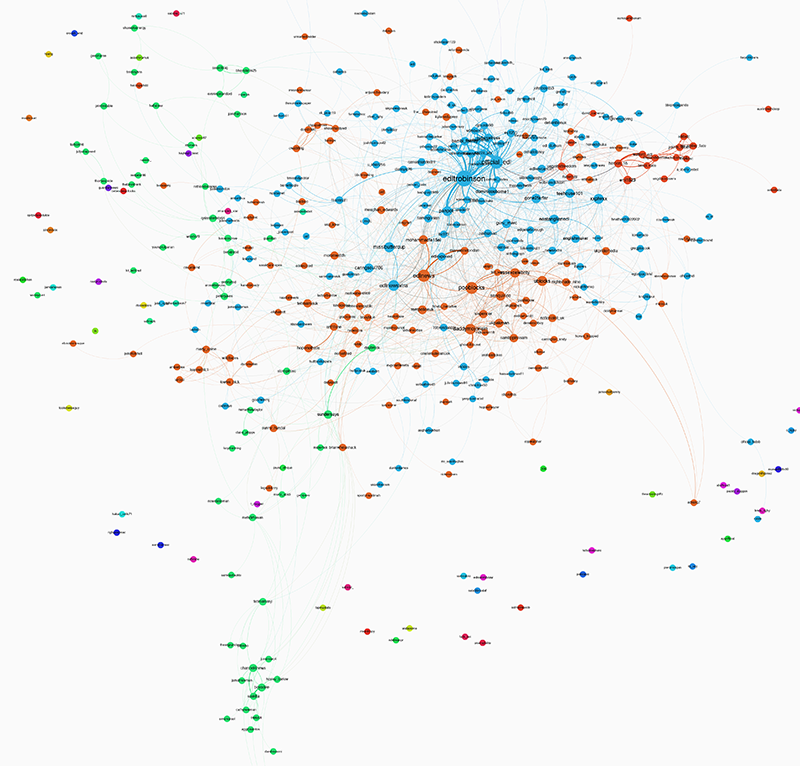
Fig. 6: Social graph by mentions for 5th June 2013 for the woolwich_historical dataset [explain parameters]. Data from DMI Twitter Capturing and Analysis Toolset (DMI-TCAT) (https://tools.digitalmethods.net/coword/twitter/analysis/), visualised with Gephi. (PDF)
On this day the news media reported that counter-terrorism police confirmed evidence of EDL graffiti at the site of a partly burned down mosque in Muswell Hill, North London (Meikle, Taylor and Dodd). Furthermore, the EDLs leader Tommy Robinson denied any role in the attack and labelled it disgusting, however the police were attempting to establish a link between the attack and the group, which was unproven but remained the most serious incident of reported abuse against the Muslim community since the Woolwich murder (Philby, Masters and Peachey).
Although Figure 5 reveals less notable polarization then Figure 6, there is still a significant large cluster primarily around @EDLTrobinson and @Official_EDL in the upper half of the graph, who are once again dominating nodes in the conversation with the 1st and 2nd most mentions respectively. They are surrounded by several EDL related users such as @CasualsUnitedNT, the organisations co-founder Kevin Carroll (@EDLKevCarroll1), and previously highlighted EDL supporters and anti-Islam users such as @XxPLWxX and @Gone2farFar. Below this cluster, we can note a smaller, and much more fragmented cluster of nodes formed around @pooblocks. Similar degree sized nodes are also in close proximity, such as @daddymojorisin, an anti-EDL user, @ukpakman, whose username is BAN the E.D.L, and @SanQuirico, an anti-fascist user. The most RT message this day (274 times), was the following by the BBC about the mosque attack:
@BBCBreaking: Counter-terror police investigate fire at London Islamic centre where EDL (English Defence League) graffiti found http://
This further strengthens the claim that social media platforms such as Twitter play an increasingly important role in news following, and indeed this news permeated through the day as anti-EDL users mentioned the attacks in reference to the EDL as a means of attributing blame to the organization, and to further garner anti-far right support. The following tweet, which was RT 158 times and remained the 9th most circulated that day:
@PennyRed: Muswell Hill mosque destroyed in suspected EDL firebomb attack. This is why we need uncompromising anti-fascism. http://t.co
In addition, these tweets highlight the symbiotic relationship between both sides, which seems to have culminated with the arson attack on the mosque:
@WaheedALiii: Why test on animals when we have EDL members?
However, this was heavily contested by the EDL, who denied any wrongdoing and is exemplified in the following tweet by their leader, which was the 4th most RT message of the day:
@EDLTrobinson: Lee Rigby's killed & people went out their way not to blame Islam but a mosque burns down quick to blame EDL it's infuriating
Most mentions: @EDLTrobinson (2,357), @official_edl (1,012), @edlnews (418), @bbcbreaking (402), @edlnewsxtra (396).
Most tweets: @panpot_ (191), @jodanielross (165), @daddymojorisin (146), @pooblocks (146), @bambi_feehily (141).
6.2. Co-hashtag analysis
6.2.1. 22nd May 2013
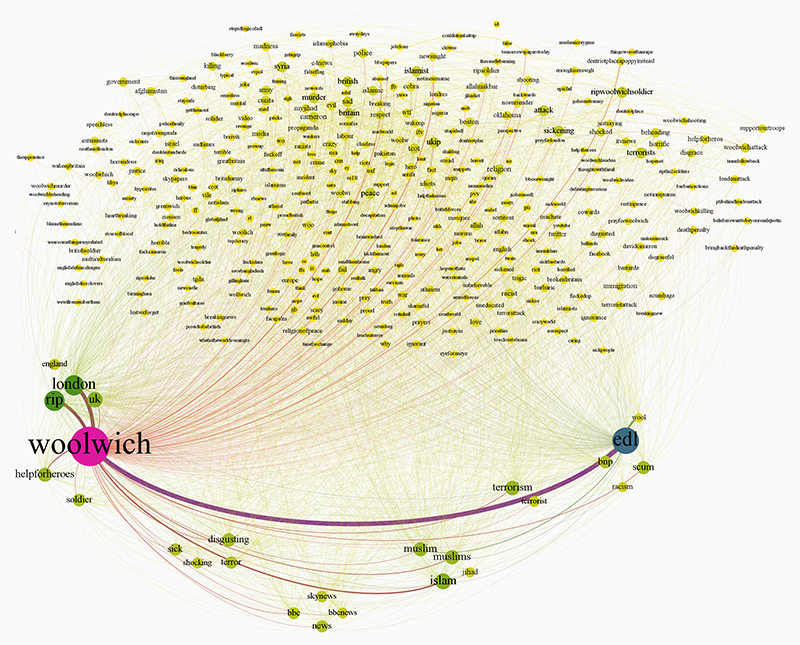
Fig. 7: Co-hashtag graph for 22nd May 2013 for the woolwich_historical dataset (Force Atlas 2). Data from DMI Twitter Capturing and Analysis Toolset (DMI-TCAT) (https://tools.digitalmethods.net/coword/twitter/analysis/), visualised with Gephi. (PDF)
As news of the savage attack exploded on Twitter a myriad of different hashtags were created and used across the platform by users. In Figure 7, we can observe that a hashtag topology had not yet been established, hence the widespread use of a varying amount of hashtags. As far as the co-hashtag analysis is concerned, #Woolwich along with the location hashtags form the dominant cluster. The second ranked cluster is formed with hashtags associated with the British far right wing, and #EDL is the dominant figure. The discourse is also formed around Islamic related hashtags such as #islam, #muslims, and #jihad. Finally, smaller in use but still significant within our topic of discussion, are the hashtags regarding the news (#bbc, #skynews, #bbcnews, #news), and sentiment (#sick, #shocking, #disgusting, #terror). Over the course of events, dominant hashtags began to prevail and the total number of used hashtags radically decreases. Meanwhile, the total sum of the hashtags used at least 3 times was 236,820. Figures 8a and 8b below illustrate the dominance of #Woolwich, used 151,876 times (81% of the top 10 hashtags). On the other hand, the hashtag #EDL was used 14,803 times and was the 2nd most popular (8% of the top 10 hashtags). This finding is related to the fact that the EDL intervened as a dominant force in online conversation on this day, however their hashtag #EDL was also appropriated by an overwhelming amount of users who condemned the far right group and its racist narrative.
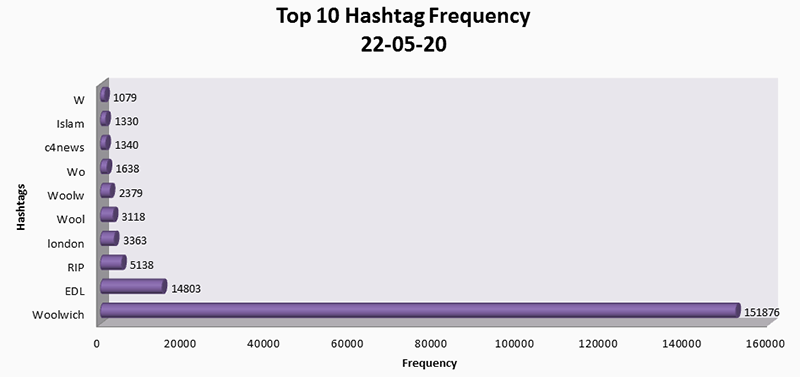
Fig. 8a: Top 10 hashtag frequency for 22nd May 2013 in the woolwich_historical dataset. Data from DMI Twitter Capturing and Analysis Toolset (DMI-TCAT) (https://tools.digitalmethods.net/coword/twitter/analysis/).
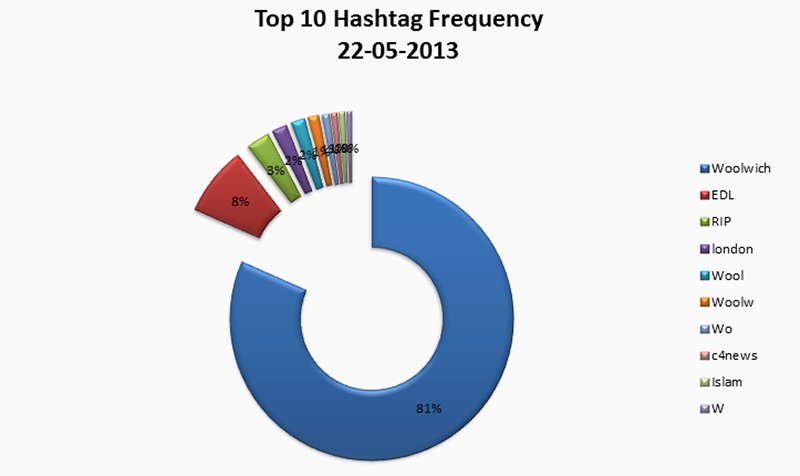
Fig. 8b: Top 10 hashtag frequency for 22nd May 2013 in the woolwich_historical dataset represented as percentages. Data from DMI Twitter Capturing and Analysis Toolset (DMI-TCAT) (https://tools.digitalmethods.net/coword/twitter/analysis/).
6.2.2. 27th May 2013
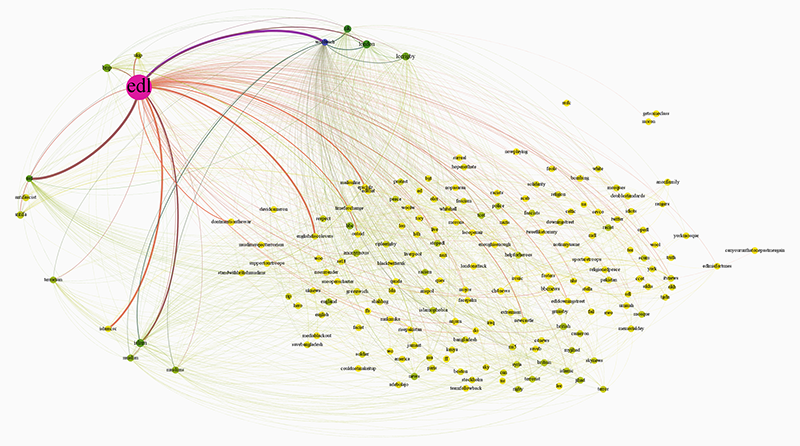
Fig. 9: Co-hashtag graph for 27th May 2013 for the woolwich_historical dataset (Force Atlas 2). Data from DMI Twitter Capturing and Analysis Toolset (DMI-TCAT) (https://tools.digitalmethods.net/coword/twitter/analysis/), visualised with Gephi. (PDF)
On 27th May, the EDL organized a march with more than 1,000 supporters protesting against Islam and the death of Lee Rigby near Downing Street in London. During this day, the hashtags in our dataset were used 52,297 times with a minimum frequency of 3, and it is interesting to observe that #Woolwich was mostly used the day of the murder as a way to spatially locate new conversation within the Twitter platform. However on 27th May, it was not so important anymore for the conversation to include so many locational hashtags. This reason along with the fact that the EDL had organized a demonstration, may exemplify why #EDL becomes the most frequently used hashtag in Figures 10a and 10b below. More specifically, the string #EDL appears 21,984 times throughout the tweets within our data set and dominates the top 10 frequency by 62%. The second most prominent hashtag is #Woolwich, since it has been used 6,464 times. It still remains one of the key hashtags in the conversation covering 18% of the top 10 hashtags. The relationship between EDL and Woolwich is depicted in the top section of Figure 9. The locational hashtags are occupying the top right corner of the graph still rallying significant prominence. In the bottom left corner of the graph below the islamist hastags appear along with the smaller in scale use of anti-fascist hastags.
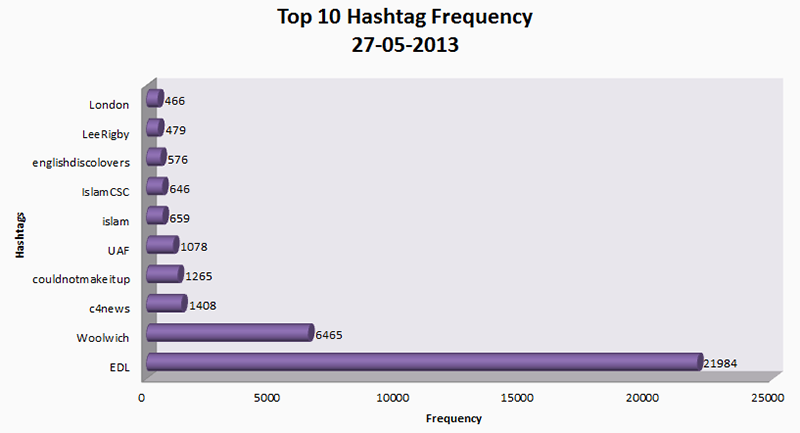
Fig. 10a: Top 10 hashtag frequency for 27th May 2013 in the woolwich_historical dataset. Data from DMI Twitter Capturing and Analysis Toolset (DMI-TCAT) (https://tools.digitalmethods.net/coword/twitter/analysis/).
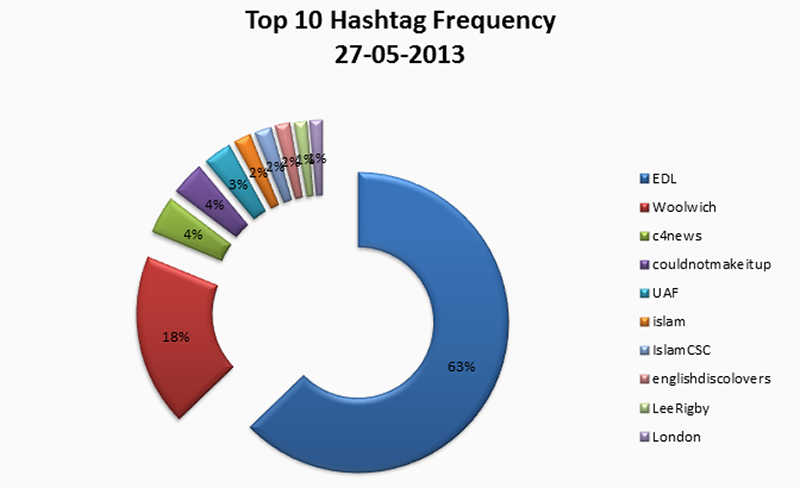
Fig. 10b: Top 10 hashtag frequency for 27th May 2013 in the woolwich_historical dataset represented as percentages. Data from DMI Twitter Capturing and Analysis Toolset (DMI-TCAT) (https://tools.digitalmethods.net/coword/twitter/analysis/).
6.2.3. 1st June 2013
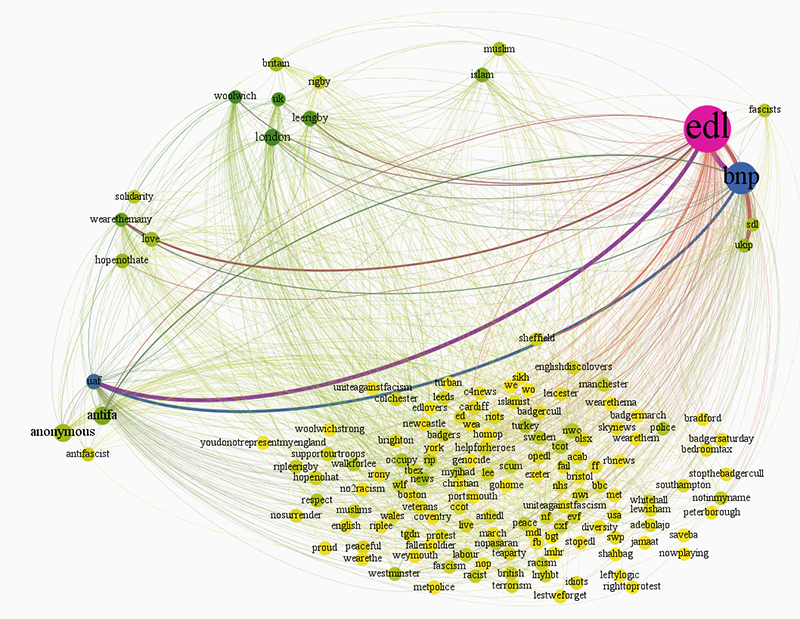
Fig. 11: Co-hashtag graph for 1st June 2013 for the woolwich_historical dataset (Force Atlas 2). Data from DMI Twitter Capturing and Analysis Toolset (DMI-TCAT) (https://tools.digitalmethods.net/coword/twitter/analysis/), visualised with Gephi. (PDF)
Before proceeding we have to stress the fact that on June 1st the number of tweets, and therefore the use of hashtags, had been declined in comparison with the day of the murder. As visible in the top right part of Figure 11 below, #EDL is once again the biggest node since it is related with most of the other hashtags. Along with #BNP, #SDL and #UKIP, they create the far right wing of the conversation. The other side of the graph is occupied by the anti-EDL polar of the discussion which is consisted of the campaign by the Hope not Hate movement and the anti-fascist hashtags. Although the discourse is polarised between the far right and the anti-fascist clusters, the appearance of hashtags like #HopeNotHate, #WeAreTheMany, #love and #solidarity gives the first signs of reconciliation in the platform. Moreover, the dominance of EDL is not only found in form of interaction but also in the frequency of appearance as it can been seen in the Figures 12a and 12b below. Nevertheless, we can detect a shift to reconciliation here as well, since #WeAreTheMany is in the second place of the frequency charts.
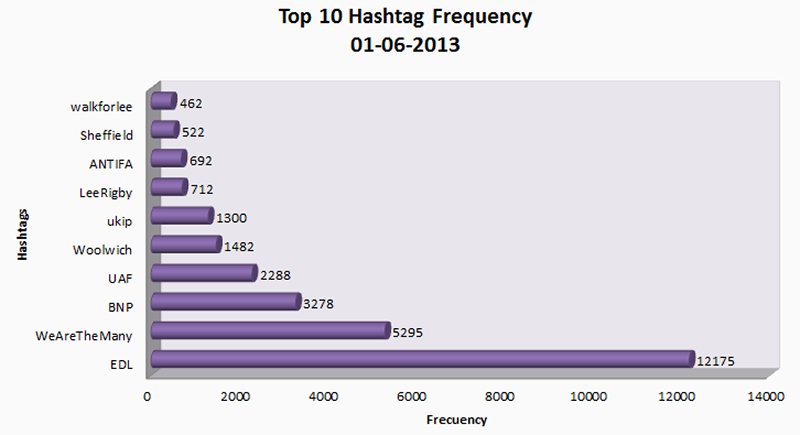
Fig. 12a: Top 10 hashtag frequency for 1st June 2013 in the woolwich_historical dataset. Data from DMI Twitter Capturing and Analysis Toolset (DMI-TCAT) (https://tools.digitalmethods.net/coword/twitter/analysis/).
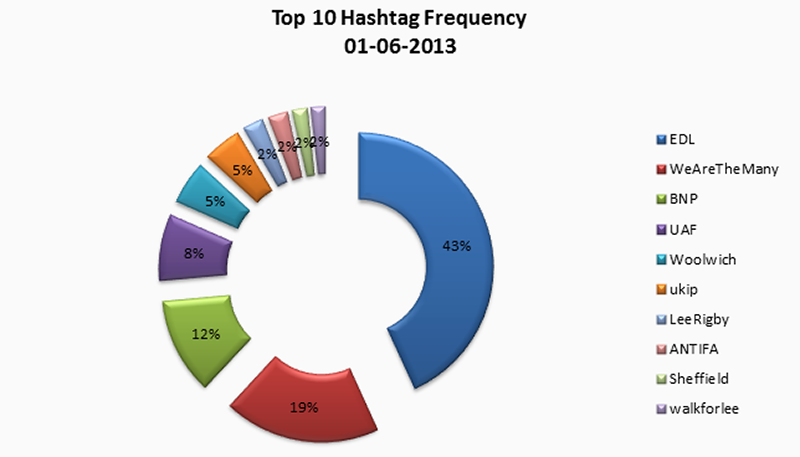
Fig. 12b: Top 10 hashtag frequency for 1st June 2013 in the woolwich_historical dataset represented as percentages. Data from DMI Twitter Capturing and Analysis Toolset (DMI-TCAT) (https://tools.digitalmethods.net/coword/twitter/analysis/).
6.2.4. 5th June 2013
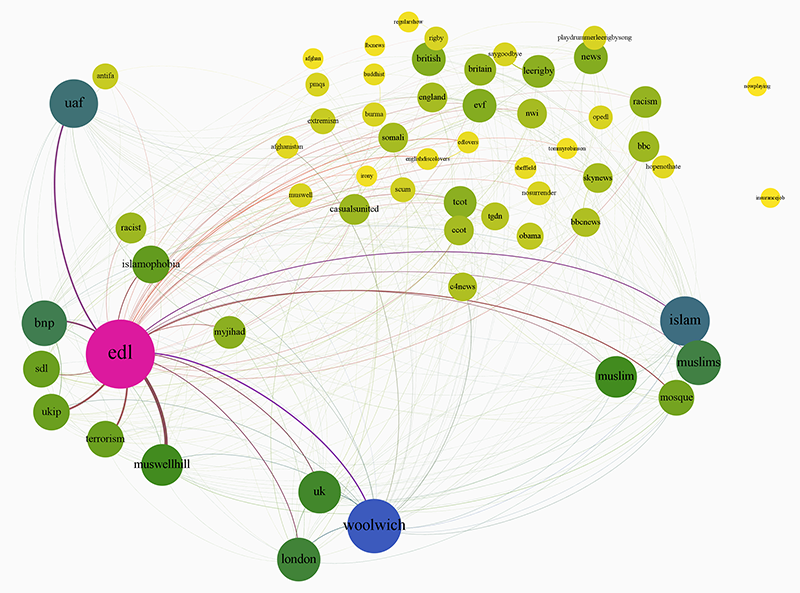
Fig. 13: Co-hashtag graph for 5th June 2013 for the woolwich_historical dataset (Force Atlas 2). Data from DMI Twitter Capturing and Analysis Toolset (DMI-TCAT) (https://tools.digitalmethods.net/coword/twitter/analysis/), visualised with Gephi. (PDF)
On 5th June an arson attack took place at the mosque in Muswell Hill. Thereafter, new hashtags also appeared and the new incident, which was considered the most extreme activity against the muslims after the murder, was heavily discussed online. The discussion was built around the far right side again, because of the EDL graffiti at the burned down mosque, and as we can see in Figure 13 below #MuswellHill is strongly connected with #EDL. English Defence League engages with both islamic and anti-fascist hashtags. Moreover, #islamophobia and #racist are correlated with them. Four days after Adebolajo was charged with the murder of Lee Rigby, the total amount of tweets had dropped to 29,657. Regarding the hashtag frequency, as we can see in Figures 14a and 14b below, EDL was again in the first place followed by two locational hashtags.
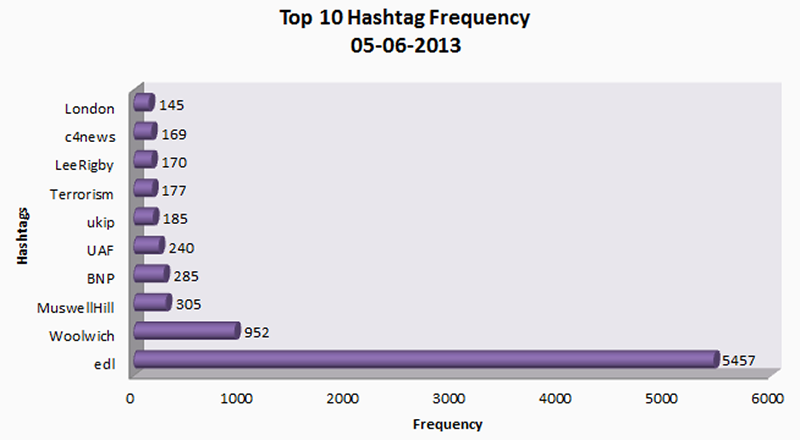
Fig. 14a: Top 10 hashtag frequency for 5th June 2013 in the woolwich_historical dataset. Data from DMI Twitter Capturing and Analysis Toolset (DMI-TCAT) (https://tools.digitalmethods.net/coword/twitter/analysis/).
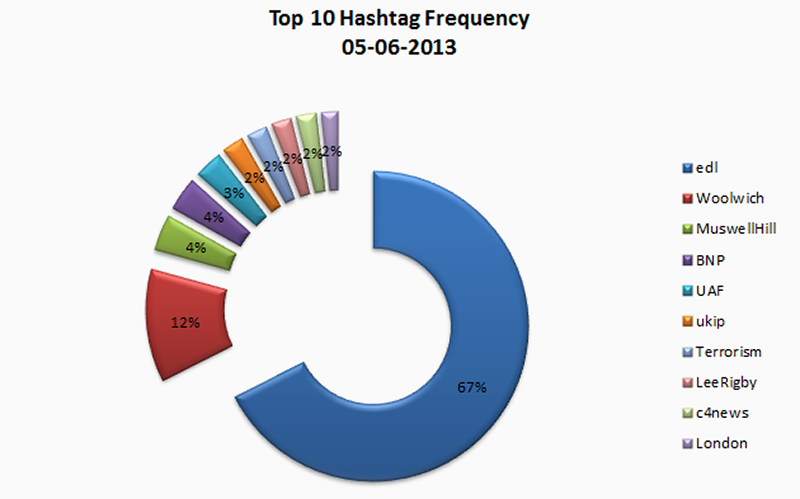
Fig. 14b: Top 10 hashtag frequency for 5th June 2013 in the woolwich_historical dataset represented as percentages. Data from DMI Twitter Capturing and Analysis Toolset (DMI-TCAT) (https://tools.digitalmethods.net/coword/twitter/analysis/).
Overall, regarding the hashtag analysis, we can summarize the following conclusions:
- The Woolwich hashtag is the one mostly used during the selected days. In terms of the discussion though, this hashtag is neutral regarding the polarization because it has locational features.
- EDL monopolizes the interest of the discussions since it is dominant in both the Co-Hashtag graph and the Frequency chart. This is an indication of polarization which can be fully verified when compared with the mention analysis.
- We can observe an interaction between the EDL and anti-fascists.
- Signs of reconciliation can be seen with the appearance of Hope not Hate movement on June 1st. The hashtags #love and #solidarity indicate positive emotions.
6.3. Retweet sentiment analysis
Using SentiStrength (developed by Mike Thelwall) allows the detection of both positive and negative value. Although the method is flawed, the analysis showed that positive sentiment (yellow bars) is generally more neutral (mostly either classified as +1 to +2), whereas negative sentiment (red bars) generally tends to be expressed in stronger language (ranging from -2 to -5). Furthermore, the size of the accumulative bars indicates the absolute number of tweets to which these sentiment values are assigned. On May 27th and June 1st, the absolute amount of sentiment is thus higher than for the other three measured points in time (Figure 15).
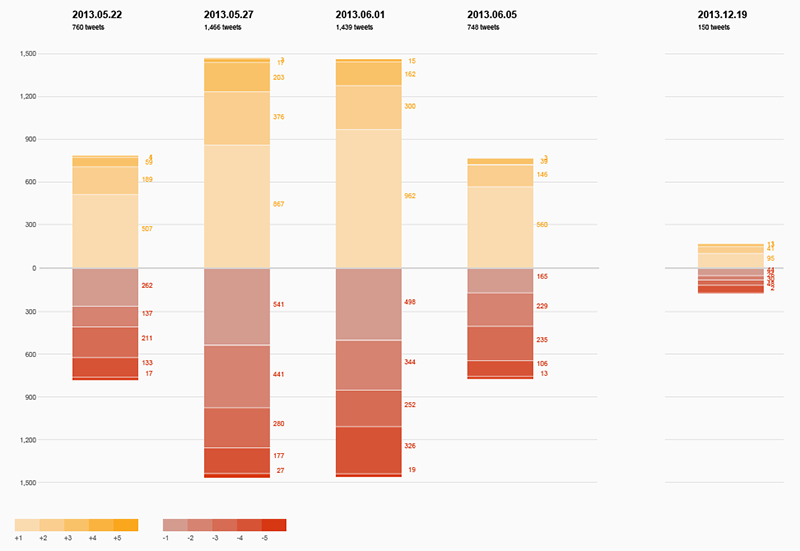
Fig. 15: Retweet sentiment analysis for [EDL] and with at least 2 retweets. Data from DMI Twitter Capturing and Analysis Toolset (DMI-TCAT) (https://tools.digitalmethods.net/coword/twitter/analysis/), analysed with SentiStrength (https://tools.digitalmethods.net/beta/senti/).
7. Discussion and conclusion
We describe how although considered a clear terrorist attack, such an attack on a relatively small scale which only mercifully only claimed 1 viction had a massive societal impact online. The Woolwich hashtag is the one mostly used during the selected days. In terms of the discussion though, this hashtag is neutral regarding the polarization because it has locational features. We document the almost instant seize of the incident by the British far right, and the continuation of dominant EDL-related discourse throughout online conversation over the course of the murders related events. The fact that EDL monopolizes the interest of the discussions since it is dominant in both the Co-Hashtag graph and the Frequency chart. In addition, we also document the opposition to the EDL, dominated by counter groups such as the UAF who engage in violence offline and discussion online with the EDL. Having in hand the Co-Hashtag, the mention and the frequency graphs we were in the position to compare them and analyze the polarization of the discussion online. Hence, we document a notable online polarization of two separate communities. This fact supports the concept of the echo chamber as originally proposed by Cass Sunstein. One side depends on the existence of the other, and by the communities engaging in this dialogue, they build up their prominence. Beyond responding to each other, the echo chamber effect applies within groups as well, as demonstrated through the clustering of similar hashtags and users.
While there was obvious polarization between communities, there were also growing attempts for reconciliation. For example, by the hashtag analysis we found the first signs of reconciliation with the appearance of Hope Not Hate on 1st June. On 27th May, a mosque, in response to the destruction of another mosque by an arson attack, invited members of an EDL march for tea and biscuits in order to start a dialogue and attempt to work out their differences, at least when it came to violence on the streets. The wider twitter community supported this kind of discussion between the groups and the hashtags #love and #solidarity indicate positive sentiment. To conclude, this report could benefit from expanded sentiment analysis, which, at this point, was not possible mostly due to time constraints and technological problems. However, it would be valuable to detect and measure growing extremist or anti-muslim sentiment.
8. Footnotes
1. 7/7 is a reference to the 7th July 2005 London bombings, which were a series of coordinated suicide attacks by extremist Islamic terrorists in central London that killed 52 civilians and injured over 700.
2. Uncensored video footage of Michael Adebolajo moments after the murder of Lee Rigby. Source: <https://www.youtube.com/watch?v=rckLU3_nCGM>.
3. Ibid.
4. Casuals United is a British far-right protest group that describes itself as Uniting the UK's Football Tribes against the Jihadists. Souce: <http://www.hopenothate.org.uk/news/article/1761/edl-rejects-barnbrook-approach>.
5. One good example is the #MyJihad hashtag, which constitutes a contested space on Twitter. Source: <https://wiki.digitalmethods.net/Dmi/Winter2014Project13> (Accessed 20th January 2014).
6. See: <http://gnip.com/>.
7. DMI Twitter Capturing and Analysis Toolset. Source: <https://tools.digitalmethods.net/coword/twitter/analysis/index.php?dataset=woolwich_historical&query=&url_query=&exclude=&from_user_name=&startdate=2013-05-22&enddate=2013-06-05&whattodo=>.
8. DMI SentiStrength. Source: <https://tools.digitalmethods.net/beta/senti/>.
9. References
Abbasi, Ahmed, Chen, Hsinchun and Salem, Arab. Sentiment Analysis in Multiple Languages: Feature Selection for Opinion Classification in Web Forums. ACM Transactions on Information Systems 26.3 (2008): 1234. Print.
About Us. HOPE not hate. n.d. Web. 16 Jan. 2014. <http://www.hopenothate.org.uk/about-us/>.
Alker, Hayward R., and Kinhide Mushakoji. "Three Times for Tomorrow. Conferencia Internacional a Construcao do Tempo e os Futuros Possiveis. Rio de Janeiro, 12 May 1999. Print.
Arceneaux, Noah, and Amy Schmitz Weiss. Seems Stupid until You Try It: Press Coverage of Twitter, 20069. New Media & Society 12.8 (2010): 1262-1279. Print.
Back, Les, Celia Lury, and Robert Zimmer. Doing Real Time Research: Opportunities and Challenges. Goldsmiths College, University of London, 2013. Print.
Borra, Erik K, and Bernhard Rieder. Programmed Method: Developing a Toolset for Capturing and Analyzing Tweets. Unpublished manuscript. Print.
boyd, danah m, and Alice Marwick. Social Privacy in Networked Publics: Teens Attitudes, Practices, and Strategies. A Decade in Internet Time: Symposium on the Dynamics of the Internet and Society, 2011. Print.
boyd, danah m, Scott Golder, and Gilad Lotan. Tweet, Tweet, Retweet: Conversational Aspects of Retweeting on Twitter. Proceedings of the 43rd Hawaii International Conference on Social Systems (HICSS) (2010): 111. Print.
Bruns, Axel, and Yuxian Eugene Liang. Tools and Methods for Capturing Twitter Data During Natural Disasters. First Monday 17.4 (2012): n.pag. Web. 18 Jan. 2014. <http://pear.accc.uic.edu/ojs/index.php/fm/article/view/3937/3193>.
Conover, Michael D et al. Political Polarization on Twitter. 5th International AAAI Conference on Weblogs and Social Media (2011): 18. Print.
Copsey, et al. "Anti - Muslim Hate Crime and the Far Right." Middlesbrough: Centre for Fascist, Anti-Fascist and Post-Fascist Studies, Teesside University, June 2013. Print.
Elmer, Greg. Live Research: Twittering an Election Debate. New Media & Society 15.1 (2013): 1830. Print.
Grierson, James. Timeline in Lee Rigby Woolwich murder case. The Independent. 19 Dec. 2013. Web. 14 Jan. 2014.<http://www.independent.co.uk/news/uk/crime/timeline-in-lee-rigby-woolwich-murder-case-9015702.htm>.
Halliday, Josh. Woolwich attack: ITV removes content from suspect's video 'confession'. The Guardian. 24 May. 2013. Web. 18 Jan. 2014
Jackson, Paul. The EDL: Britains New Far Right Social Movement. RNM Publications. Northampton: Radicalism and New Media Research Group, University of Northampton, 2011. Print.
Laville, Sandra, Peter Walker, and Vikram Dodd. Woolwich attack suspect identified as Michael Adebolajo. The Guardian. Guardian News and Media Limited, 23 May 2013. Web.15 Jan. 2014. <http://www.theguardian.com/uk/2013/may/23/woolwich-attack-suspect-michael-adebolajo>.
Lowles, Nick. Counter Jihadism: Introduction. HOPE not hate. 24 Aug. 2012. Web. 21 Dec. 2012. <http://www.hopenothate.org.uk/counter-jihad/>.
Lowles, Nick, and Joe Mulhall. Gateway to Terror: Anjem Choudary and the al-Muhajiroun network. HOPE not hate: London, 2013.
Manning, Lucy. Lee Rigby's murderers wanted martyrdom they will get jail. ITV News. ITV plc, 19 Dec. 2013. Web. 20 Jan. 2014. <http://www.itv.com/news/2013-12-19/lee-rigbys-murderers-wanted-martyrdom-theyll-get-jail/>.
Marres, Noortje S, and Esther Weltevrede. Scraping the Social?. Journal of Cultural Economy 6.3 (2013): 313335. Print.
Marres, Noortje S, and Richard A Rogers. Subsuming the Ground: How Local Realities of the Fergana Valley, the Narmada Dams, and the BTC Pipeline Are Put to Use on the Web. Economy and Society (2008): 251281. Print.
Marwick, Alice E, and danah m boyd. I Tweet Honestly, I Tweet Passionately: Twitter Users, Context Collapse, and the Imagined Audience. New Media & Society 13.1 (2011): 114133. Print.
Meikle, James, Matthew Taylor and Vikram Dodd. Police investigate fire at Islamic community centre in Muswell Hill. The Guardian. Guardian News and Media Limited, 5 June 2013. Web. 16 Jan. 2014. <http://www.theguardian.com/uk/2013/jun/05/fire-islamic-community-centre-muswell-hill>.
Mitchell, Amy, and Paul Hitlin. Twitter Reaction to Events Often at Odds with Overall Public Opinion. Pew Research Center. 4 Mar. 2013. Web. 18 Jan. 2014. <http://www.pewresearch.org/2013/03/04/twitter-reaction-to-events-often-at-odds-with-overall-public-opinion/>.
Moon, Timur. Ukip Activist Marty Caine Provokes Fury by Branding Drummer Lee Rigby's Family 'Idiots'. International Business Times. 1 June 2013. Web. 14 Jan. 2014. <http://www.ibtimes.co.uk/lee-riby-marty-caine-idots-ukip-473545>.
OCallaghan, Derek et al. Uncovering the Wider Structure of Extreme Right Communities Spanning Popular Online Networks. Proceedings of the 5th Annual ACM Web Science Conference (2013): 276-285. Print.
Pipes, Daniel. The U.S. Institute of Peace Stumbles. Daniel Pipes: Middle East Forum. 23 March 2004. Web. 15 Jan. 2014. <http://www.danielpipes.org/1659/the-us-institute-of-peace-stumbles>.
Puschmann, Cornelius, and Jean Burgess. The Politics of Twitter Data. Alexander von Humboldt, Institut Für Internet und Gesellschaft, 2013. Print.
Quinn, Ben. EDL Blames Islam for Woolwich Attack at Downing Street Protest. The Guardian. Guardian News and Media Limited, 27 May 2013. Web. 15 Jan. 2014. <http://www.theguardian.com/uk/2013/may/27/edl-protesters-blame-islam-woolwich-attack>.
Rieder, Bernhard. The Refraction Chamber: Twitter as Sphere and Network. First Monday 17.11 (2012): n. pag. Web. <http://firstmonday.org/ojs/index.php/fm/article/view/4199/3359>.
Rogers, Richard A. Debanalizing Twitter: the Transformation of an Object of Study. Proceedings of the 5th Annual ACM Web Science Conference (Web Sci '13) (2013): 356365. Print.
---. Digital Methods. Cambridge, MA: The MIT Press, 2013. Print.
Simcox, Robin et. al. Islamist Terrorism: The British Connections. 2nd ed. London: The Henry Jackson Society, 2011. Print.
Starbird, Kate, Grace Muzny, and Leysia Palen. Learning From the Crowd: Collaborative Filtering Techniques for Identifying on-the-Ground Twitterers During Mass Disruptions. Proceedings of the 9th International ISCRAM Conference (2012): 110. Print.
Stone, Biz. Twitter Search for Everyone! Twitter Blog. Twitter Inc., 2009. Web. 3 Dec. 2013. <https://blog.twitter.com/2009/twitter-search-everyone>.
Sunstein, Cass. Fragmentation and Cybercascades. Republic.com. Princeton: Princeton University Press, 2001. 5188. Print.
The Al-Muhajiroun Network. HOPE not hate. n.d. Web. 15 Dec. 2014. <http://www.hopenothate.org.uk/hate-groups/am/>.
Thelwall, Mike, Kevan Buckley, and Georgios Paltoglou. Sentiment in Twitter Events. Journal of the American Society for Information Science and Technology 62.2 (2011): 406418. Print.
Thelwall, Mike. Sentiment Strength Detection for the Social Web. Journal of the American Society for Information Science and Technology 63.1 (2012): 163173. Print.
What is the English Defence League?. HOPE not hate. n.d. Web. 15 Dec. 2014. <http://www.hopenothate.org.uk/hate-groups/edl/>.
Woolwich: Michael Adebolajo charged with Lee Rigby murder. BBC News UK. British Broadcasting Company, 1 June 2013. Web. 16 Jan. 2014. <http://www.bbc.co.uk/news/uk-22743438>.
Woolwich: The Untold Story. BBC Panorama. BBC One, British Broadcasting Company. 19 Dec. 2013. Television.
 Copyright © by the contributing authors. All material on this collaboration platform is the property of the contributing authors.
Copyright © by the contributing authors. All material on this collaboration platform is the property of the contributing authors. Ideas, requests, problems regarding Foswiki? Send feedback


